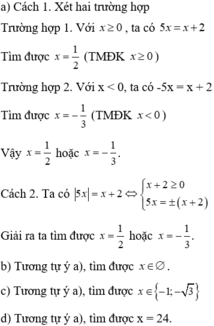
Hãy nhập câu hỏi của bạn vào đây, nếu là tài khoản VIP, bạn sẽ được ưu tiên trả lời.


Ta có x + y + z = 0
<=> (x + y + z)2 = 0
<=> \(x^2+y^2+z^2+2xy+2yz+2zx=0\)
\(\Leftrightarrow xy+yz+zx=-3\) (vì x2 + y2 + z2 = 6)
\(\Leftrightarrow x\left(y+z\right)+yz=-3\)
\(\Leftrightarrow-x^2+yz=-3\Leftrightarrow yz=x^2-3\) (vì x + y + z = 0)
Khi đó \(x^3+y^3+z^3=x^3+(y+z).(y^2+z^2-yz)\)
\(=x^3-x.[6-x^2-(x^2-3)]\)
\(=x^3-x.(9-2x^2)=3x^3-9x=6\)
Ta được \(\Leftrightarrow x^3-3x-2=0\Leftrightarrow(x^3+1)-3(x+1)=0\)
\(\Leftrightarrow(x+1)(x^2-x-2)=0\)
\(\Leftrightarrow\left(x+1\right)^2\left(x-2\right)=0\)
\(\Leftrightarrow\left[{}\begin{matrix}x=-1\\x=2\end{matrix}\right.\)
Với x = -1 ta có hệ \(\left\{{}\begin{matrix}y+z=1\\y^2+z^2=5\end{matrix}\right.\Leftrightarrow\left\{{}\begin{matrix}y=1-z\\(1-z)^2+z^2=5\end{matrix}\right.\Leftrightarrow\left\{{}\begin{matrix}y=1-z\\z^2-z-2=0\end{matrix}\right.\Leftrightarrow\left\{{}\begin{matrix}y=1-z\\\left[{}\begin{matrix}z=-1\\z=2\end{matrix}\right.\end{matrix}\right.\)
\(\Leftrightarrow\left[{}\begin{matrix}\left\{{}\begin{matrix}y=2\\z=-1\end{matrix}\right.\\\left\{{}\begin{matrix}y=-1\\z=2\end{matrix}\right.\end{matrix}\right.\)
Với x = 2 ta có hệ : \(\left\{{}\begin{matrix}y+z=-2\\y^2+z^2=2\end{matrix}\right.\Leftrightarrow\left\{{}\begin{matrix}y=-2-z\\(-2-z)^2+z^2=2\end{matrix}\right.\Leftrightarrow\left\{{}\begin{matrix}y=-2-z\\z^2+2z+1=0\end{matrix}\right.\)
\(\Leftrightarrow\left\{{}\begin{matrix}y=-2-z\\z=-1\end{matrix}\right.\Leftrightarrow y=z=-1\)
Vậy (x;y;z) = (2;-1;-1) ; (-1 ; 2 ; -1) ; (-1 ; -1 ; 2)

\(y^2-7y-8=0\Rightarrow\orbr{\begin{cases}y=-1\\y=8\end{cases}}\)
\(\Rightarrow\orbr{\begin{cases}x=\sqrt[3]{-1}=-1\\x=\sqrt[3]{8}=2\end{cases}}\)

a) Phương trình \(7x + \dfrac{4}{7} = 0\) là phương trình bậc nhất một ẩn vì có dạng \(ax + b = 0\) với \(a\) và \(b\) là các hệ số đã cho và \(a \ne 0\), \(x\) là ẩn số.
Khi đó, \(a = 7;b = \dfrac{4}{7}\).
b) \(\dfrac{3}{2}y - 5 = 4\)
\(\dfrac{3}{2}y - 5 - 4 = 0\)
\(\dfrac{3}{2}y - 9 = 0\)
Phương trình \(\dfrac{3}{2}y - 9 = 0\) là phương trình bậc nhất một ẩn vì có dạng \(ay + b = 0\) với \(a\) và \(b\) là các hệ số đã cho và \(a \ne 0\), \(y\) là ẩn số.
Khi đó, \(a = \dfrac{3}{2};b = - 9\)
c) Phương trình \(0t + 6 = 0\) không là phương trình bậc nhất một ẩn.
Mặc dù phương trình đã cho có dạng \(at + b = 0\) với \(a\) và \(b\) là các hệ số đã cho nhưng \(a = 0\).
d) Phương trình \({x^2} + 3 = 0\) không là phương trình bậc nhất một ẩn vì không có dạng \(ax + b = 0\) với \(a\) và \(b\) là các hệ số đã cho và \(a \ne 0\), \(x\) là ẩn số (do có \({x^2}\)).

Cái này t dùng máy tính
\(\left(x-2\right)\left(x+3\right)\left(2x+1\right)\left(3x-1\right)=0\)
Đến đây thì pt có 4 nghiệm:\(x=2;-3;-\frac{1}{2};\frac{1}{3}\)
Vậy....

1:
a: =>3x=6
=>x=2
b: =>4x=16
=>x=4
c: =>4x-6=9-x
=>5x=15
=>x=3
d: =>7x-12=x+6
=>6x=18
=>x=3
2:
a: =>2x<=-8
=>x<=-4
b: =>x+5<0
=>x<-5
c: =>2x>8
=>x>4

Câu 1: xin sửa đề :D
CM: \(n\left(n+1\right)\left(n+2\right)\left(n+3\right)+1\)là 1 scp
\(n\left(n+1\right)\left(n+2\right)\left(n+3\right)+1\)
\(=\left(n^2+3n\right)\left(n^2+3n+2\right)+1\)
\(=\left(n^2+3n\right)^2+2\left(n^2+3n\right)+1\)
\(=\left(n^2+3n+1\right)^2\)là scp

\(\orbr{\begin{cases}x^3=-1\\x^3=8\end{cases}\Rightarrow}\orbr{\begin{cases}x=-1\\x=2\end{cases}}\)

\(x^3-7x+6=0\)
\(\Leftrightarrow x^3-x^2+x^2-x-6x+6=0\)
\(\Leftrightarrow x^2\left(x-1\right)+x\left(x-1\right)-6\left(x-1\right)=0\)
\(\Leftrightarrow\left(x^2+x-6\right)\left(x-1\right)=0\)
\(\Leftrightarrow\left(x^2-2x+3x-6\right)\left(x-1\right)=0\)
\(\Leftrightarrow\left[x\left(x-2\right)+3\left(x-2\right)\right]\left(x-1\right)\)
\(\Leftrightarrow\left(x-2\right)\left(x+3\right)\left(x-1\right)=0\)
\(\Rightarrow x=\left\{-3;1;2\right\}\)

Đặt \(x^3=y\)
Khi đó pt trở thành \(y^2-7y+6=0\)
\(\Leftrightarrow y^2-6y-y+6=0\)
\(\Leftrightarrow\left(y-6\right)\left(y-1\right)=0\)
\(\Leftrightarrow\orbr{\begin{cases}y-6=0\\y-1=0\end{cases}\Leftrightarrow}\orbr{\begin{cases}y=6\\y=1\end{cases}}\)
\(\left(+\right)y=1\Rightarrow x^3=1\Leftrightarrow x=1\)
\(\left(+\right)y=6\Rightarrow x^3=6\Leftrightarrow x=\sqrt[3]{6}\)
Vậy phương trình có nghiệm \(x=1;x=\sqrt[3]{6}\)